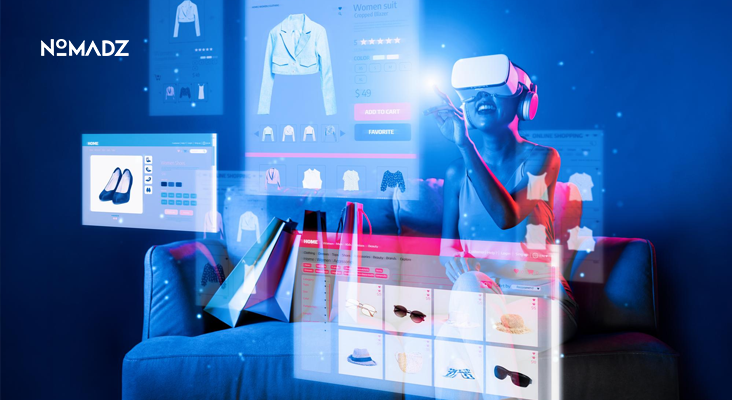Leveraging Augmented Reality for Enhanced Shopping Experiences
The shopping behavior has been transformed over the last few years. Technology has been transforming the retail experience, and the trend remains as e-commerce platforms and custom social media stores are introduced through mobile apps. One of the innovations that can be regarded as a real game-changer in 2025 is augmented reality in the retail sector. It is a radical technology that is altering the way consumers learn, experience, and purchase products, and is making the shopping experience more interactive, personalized, and entertaining.
The Rise of Augmented Reality in Retail
In the modern world, the buyer is not interested in convenience alone, but in interaction and relationships. The latter is something that traditional marketing cannot provide, but augmented reality in retail can. AR superimposes digital images, 3D models, or information on the real world by case smartphones or AR devices. It provides customers the opportunity to interrelationship with products in completely new ways.
AR fills the gap between imagination and reality, whether virtually trying on a new pair of sunglasses, viewing how a couch will look in the living room, or viewing the features of a car in 3-D. It also makes shopping less guessing and more fulfilling, and that is why more and more brands are switching to it annually.
Also Read: Role of AI in Retargeting to Enhance Strategies
Transforming Shopping Through AR
1. Virtual Try-Ons and Visualization
Lack of the ability to see or touch the product is one of the largest obstacles to online shopping. AR shopping experiences do away with that suspicion. Using only a smartphone camera, a customer is able to try on a piece of clothing, test the shade of the makeup, or view the appearance of home decor in his or her place of residence before purchasing.
Such a degree of visualization creates buyer confidence and lowers product returns significantly. Nothing is surprising about the fact that big brands in the beauty and fashion industry, as well as furniture, already include AR in their very fabric of retailing.
2. Interactive In-Store Experiences
Augmented reality in the retail world, even at the physical stores, is transforming customer interaction with the products. The shoppers are allowed to scan items to unlock concealed information like styling ideas, reviews, or sustainability information. Certain brands are also developing online storefronts, where windows animate or have virtual personalities when a smartphone is used.
This combination of online and offline stores is exciting, as the visits to the physical stores become new once again.
3. Personalized Recommendations
In combination with artificial intelligence, AR will enable retailers to use personalized recommendations in real-time. As an example, when a customer tries on a jacket, he or she will immediately view accessories or shoes that match. Such intelligent recommendations enhance user experiences and user confidence.
Combinations of augmented reality in retailing and customer data allow the brands to design genuinely personal shopping experiences.
Boosting Customer Engagement with AR
Customer engagement is a crucial factor in the success of modern retail. AR turns the act of shopping into a two-way interaction that makes the process of shopping natural and exciting.
Retailers are looking at new ways of engaging customers. Whether it is interactive AR filters on social media or games based on brand campaigns. Think about a situation where you scan a QR code to open a virtual treasure hunt or receive a discount to a game based on AR. These experiences are not only entertaining but also lead to increased brand loyalty.
It is these kinds of playful, immersive experiences that drive customers to return, and as such, AR shopping experiences make it one of the most effective marketing tools in the year 2025.
The Role of Immersive Technology
The immersive technology has been advancing at a very fast rate, and this is pushing the limits of retail to the furthest heights! AR is no longer exclusive to large companies, but it is also implemented by small businesses with the help of inexpensive plugins and apps. Online stores are now equipped with View in Your Room applications or a virtual dressing room that helps in product knowledge.
Together with the high-speed 5G networks and enhanced mobile cameras, augmented reality in retailing is becoming easier and more available. The future of shopping will likely combine AR with virtual reality (VR) and offer truly hybrid experiences that would involve both online and offline worlds inseparably.
The Future of AR in Shopping
Although the development costs and user adoption are challenges, the benefits of AR are much higher. With the technology still developing, the shopping experience will only be more realistic and interactive, with customized avatars and virtual showrooms.
The augmented reality in retail will cease to be a revolution in the next several years. It will become a prerequisite. The current brands investing in AR are laying the groundwork for the future of shopping, a smarter, more interactive, and customer-centric one.
Also Read: Transforming AI in Marketing Using Modern Tools
Final Thoughts
AR is transforming retail in terms of staying in one place to a dynamic journey. It is not only a product presentation device, but it is also a connection between fantasy and reality. Using augmented reality in retailing will help the brands to establish closer relationships with their customers. So, have more interactions with them, and provide them with AR shopping experiences that will be fascinating and rewarding.
The future of the shopping process is going to be shaped by the people. These people who will be able to make the digital processes so human, intuitive, and memorable.









Leave feedback about this